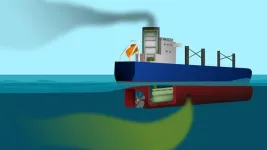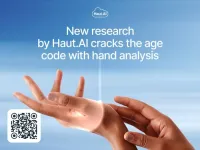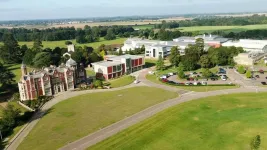(Press-News.org) A feast cooked up by UBC researchers has revealed singlet oxygen indoors for the first time.
Oxi-don’t
Singlet oxygen is an oxidant. These chemical compounds can be beneficial—ozone in the stratosphere is one example—but can also cause stress to our lungs, contributing to the development of cancer, diabetes, and heart disease in the long term.
Cooking foods can release brown carbon, molecules with the potential to create oxidants when they absorb light. In addition, exposure to cooking emissions has been linked to chronic diseases in chefs.
Historically, it was thought there wasn’t enough light indoors to have much reactive chemistry, but there are many light sources in modern kitchens.
Sprouts + sunlight = oxidant
UBC researchers thought if all the right ingredients were in place—namely, cooking in a lit area—they might find singlet oxygen indoors where it had never been detected.
They investigated by cooking three meals representing breakfast, lunch and dinner: pancakes, Brussels sprouts, and vegetable stir fry, sampling the air and exposing it to three different types of light: UV, sunlight, and fluorescent.
They detected singlet oxygen at around the same concentration for all three dishes. However, its highest concentration occurred in sunlit experiments, meaning naturally lit kitchens likely see more of this oxidant.
Venting is healthy
The COVID-19 pandemic has helped raise public awareness of indoor air quality.
The researchers recommend ventilation and air filtration in kitchens to reduce exposure to aerosols while cooking.
“Our next steps include determining just how this oxidant might affect humans and how much we’re breathing in when we cook. Could it play a role in some cooking-related diseases?” said senior author Dr. Nadine Borduas-Dedekind, UBC chemistry assistant professor.
END
Scientists cooked pancakes, Brussels sprouts, and stir fry to detect an oxidant indoors for the first time
2024-05-07
ELSE PRESS RELEASES FROM THIS DATE:
Quantum breakthrough: World’s purest silicon brings scientists one step closer to scaling up quantum computers
2024-05-07
More than 100 years ago, scientists at The University of Manchester changed the world when they discovered the nucleus in atoms, marking the birth of nuclear physics.
Fast forward to today, and history repeats itself, this time in quantum computing.
Building on the same pioneering method forged by Ernest Rutherford – "the founder of nuclear physics" – scientists at the University, in collaboration with the University of Melbourne in Australia, have produced an enhanced, ultra-pure form of silicon that allows ...
New super-pure silicon chip opens path to powerful quantum computers
2024-05-07
Researchers at the Universities of Melbourne and Manchester have invented a breakthrough technique for manufacturing highly purified silicon that brings powerful quantum computers a big step closer.
The new technique to engineer ultra-pure silicon makes it the perfect material to make quantum computers at scale and with high accuracy, the researchers say.
Project co-supervisor Professor David Jamieson, from the University of Melbourne, said the innovation – published today in Communication Materials, a Nature journal – uses qubits of phosphorous atoms implanted ...
Millions in costs due to discharge of scrubber water into the Baltic Sea
2024-05-07
Discharge from ships with so-called scrubbers cause great damage to the Baltic Sea. A new study from Chalmers University of Technology, Sweden, shows that these emissions caused pollution corresponding to socio-economic costs of more than EUR 680 million between 2014 and 2022. At the same time, the researchers note that the shipping companies' investments in the much-discussed technology, where exhaust gases are "washed" and discharged into the sea, have already been recouped for most of the ships. This means that the industry is now making billions ...
Bio-inspired materials’ potential for efficient mass transfer boosted by a new twist on a century-old theory
2024-05-07
The natural vein structure found within leaves – which has inspired the structural design of porous materials that can maximise mass transfer – could unlock improvements in energy storage, catalysis, and sensing thanks to a new twist on a century-old biophysical law.
An international team of researchers, led by the NanoEngineering Group at the Cambridge Graphene Centre, has developed a new materials theory based on ‘Murray’s Law’, applicable to a wide range of next-generation functional ...
Small pump for kids awaiting heart transplant shows promise in Stanford Medicine-led trial
2024-05-07
A small, implantable cardiac pump that could help children await heart transplants at home, not in the hospital, has performed well in the first stage of human testing.
The pump, a new type of ventricular assist device, or VAD, is surgically attached to the heart to augment its blood-pumping action in individuals with heart failure, allowing time to find a donor heart. The new pump could close an important gap in heart transplant care for children.
In a feasibility trial of seven children who received the new pump to support their failing hearts, six ultimately underwent heart transplants ...
Time flies, but your hands tell: Haut.AI cracks the age code with hand analysis
2024-05-07
Tallinn, Estonia – 7th May 2024, 10 AM CET – Haut.AI, a leader in responsible skincare artificial intelligence (AI) development, today announced a breakthrough research paper demonstrating the effectiveness of using hand images for accurate age prediction. This innovative approach offers a viable alternative to traditional facial photo methods and promotes fairer AI solutions.
The study, titled “Predicting human chronological age via AI analysis of dorsal hand versus facial images: A study in a cohort of Indian females,” shows that AI models trained on hand images achieve comparable accuracy to those using facial images, with an average error of ...
Babraham Institute receives £48M strategic investment from BBSRC for a four-year programme of work to promote lifelong health
2024-05-07
Following a quinquennial review by the Biotechnology and Biological Sciences Research Council (BBSRC), the Babraham Institute will receive £48m for the period 2024-2028 to advance research on the mechanisms that maintain the health of our cells, tissues and organs across the life course.
This work is key in driving BBSRC’s strategic research priorities around an integrated understanding of health, developing and applying transformative technologies and advancing our understanding of the rules of life.
As one of eight UK bioscience ...
Childhood sedentariness linked to premature heart damage – light physical activity reversed the risk
2024-05-07
An increase in sedentary time from childhood caused progressing heart enlargement, a new study shows. However, light physical activity could reduce the risk. The study was conducted in collaboration between the Universities of Bristol and Exeter, and the University of Eastern Finland, and the results were published in the prestigious European Journal of Preventive Cardiology.
Left ventricular hypetrophy refers to an excessive increase in heart mass and size. In adults, it is known to increase the risk for heart attacks, stroke, and premature death.
In the present study, 1,682 children ...
Parents’ watchful eye may keep young teens from trying alcohol, drugs: Study
2024-05-07
PISCATAWAY, NJ – Teenagers are less likely to drink, smoke or use drugs when their parents keep tabs on their activities--but not necessarily because kids are more likely to be punished for substance use, suggests a new study in the Journal of Studies on Alcohol and Drugs.
Researchers found that, contrary to common belief, parents’ “monitoring” does not seem to boost the odds of catching their kids using substances. However, when kids simply are aware that their parents are monitoring behavior, they avoid trying alcohol or drugs in the first place.
It is the fear of being caught, rather than actually being punished.
Many studies ...
A triumph of galaxies in three new images from the VST
2024-05-07
FOR IMMEDIATE RELEASE
Distant, far away galaxies. Interacting galaxies, whose shape has been forged by the mutual gravitational influence, but also galaxies forming groups and clusters, kept together by gravity. They are the protagonists of three new images released by the VLT Survey Telescope (VST).
VST is an optical telescope with a 2,6 diameter mirror, entirely built in Italy, that has been operating since 2011 at the European Southern Observatory’s (ESO) Paranal Observatory in Chile. Since 2022, the telescope has been fully managed by INAF through the National Coordination Centre for VST, ...





